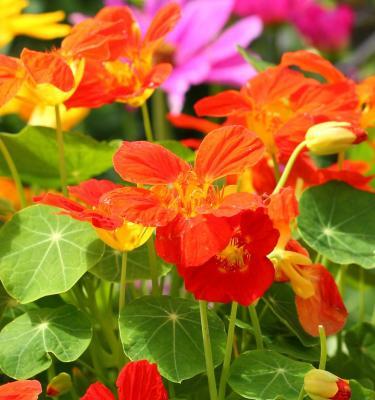Nasturtium Plant
Neem, a versatile tree, thrives in well-drained soil and full sun exposure. With a fast growth rate, it's hardy in zones 10-12. Known for its medicinal properties, Neem leaves are often used in traditional remedies.

Habit
Climbing/Spreading
Height
0.3-0.5 m
Growth
Annual
Soil
Well-drained, sandy loam
Shade
Full Sun
Moisture
Moderate
Edible
Yes
Medicinal
Yes
Origin
South America
Climatic Condition
Tropical, Subtropical
Temperature (°)
18-22°C
Humidity (%)
50-60%
Potting media
Loamy, peat
Fertilizers
Organic, balanced NPK
Watering
Regular, deep watering
Plant Weight
50-100 g
Flowering Time
Spring, Summer
Soil Ph level
6.0 - 7.5
Water Ph level
6.0 - 7.5
Soil EC
1-2 dS/m
Yield Per Plant
Edible flowers
NPK ratio
05:10:10
life Span
Annual
Health Benefits
Rich in vitamin C, edible leaves
Suggested Grow Media or Potting Mix ?
50% compost, 30% perlite, 20% peat moss
Suggested Fertigation/Fertilizers
Fertilize every 4 weeks with a balanced, water-soluble fertilizer.
Common Diseases and Remedies
Start writing here...
Downy Mildew, Aphids, Leaf Miner, Gray Mold, Powdery Mildew.
Yellow spots on leaves, white mold on undersides Yellowing leaves, sticky residue on leaves White, winding trails on leaves Gray, fuzzy mold on leaves and flowers White powdery growth on leaves
Neem oil, garlic spray Insecticidal soap, ladybugs Neem oil, spinosad Improve air circulation, remove affected parts Neem oil, baking soda spray
Fungicides with mefenoxam, Insecticides containing imidacloprid, Systemic insecticides Iprodione or thiophanate-methyl, Sulfur-based fungicides.
HEALTH BENEFITS
- Natural antibiotic properties, helping fight infections.
- Rich in vitamin C, supporting immunity.
- Used in traditional medicine for respiratory issues.
- Promotes wound healing when applied topically.

